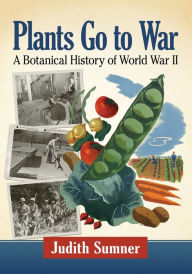Ebook pc download Plants Go to War: A Botanical History of World War II by Judith Sumner (English Edition)
Par dewitt roxanne le jeudi, avril 23 2020, 02:08 - Lien permanent
Plants Go to War: A Botanical History of World War II. Judith Sumner

Plants-Go-to-War-A.pdf
ISBN: 9781476676128 | 366 pages | 10 Mb

- Plants Go to War: A Botanical History of World War II
- Judith Sumner
- Page: 366
- Format: pdf, ePub, fb2, mobi
- ISBN: 9781476676128
- Publisher: McFarland & Company, Incorporated Publishers
Ebook pc download Plants Go to War: A Botanical History of World War II by Judith Sumner (English Edition)
As the first botanical history of World War II, Plants Go to War examines military history from the perspective of plant science. From victory gardens to drugs, timber, rubber, and fibers, plants supplied materials with key roles in victory. Vegetables provided the wartime diet both in North America and Europe, where vitamin-rich carrots, cabbages, and potatoes nourished millions. Chicle and cacao provided the chewing gum and chocolate bars in military rations. In England and Germany, herbs replaced pharmaceutical drugs; feverbark was in demand to treat malaria, and penicillin culture used a growth medium made from corn. Rubber was needed for gas masks and barrage balloons, while cotton and hemp provided clothing, canvas, and rope. Timber was used to manufacture Mosquito bombers, and wood gasification and coal replaced petroleum in European vehicles. Lebensraum, the Nazi desire for agricultural land, drove Germans eastward; troops weaponized conifers with shell bursts that caused splintering. Ironically, the Nazis condemned non-native plants, but adopted useful Asian soybeans and Mediterranean herbs. Jungle warfare and camouflage required botanical knowledge, and survival manuals detailed edible plants on Pacific islands. Botanical gardens relocated valuable specimens to safe areas, and while remote locations provided opportunities for field botany, Trees surviving in Hiroshima and Nagasaki live as a symbol of rebirth after vast destruction.
Lawn - Wikipedia
A lawn is an area of soil-covered land planted with grasses and other durable plants such as .. Soon, farmers began to purposefully plant new species of grass in these areas, hoping to After World War II, the lawn aesthetic once again became a standard feature of North .. The Lawn: A History of an American Obsession.
History of Peanuts & Peanut Butter | National Peanut Board
The peanut plant probably originated in Peru or Brazil in South America. as a food for livestock and the poor and were considered difficult to grow and harvest. butter and jelly sandwich for sustenance during maneuvers in World War II.
Buy Plants Go to War: A Botanical History of World War II Book
As first botanical history of World War II, Plants Go to War examines military history from the perspective of plant science. From victory gardens to drugs, timber,
A Brief History of Our Deadly Addiction to Nitrogen Fertilizer
Nitrogen is one of the nutrient elements plants need to grow. Plant-available nitrogen, known as nitrate, is actually scarce, and for most of agriculture's By the end of World War II, the United States had built 10 large-scale
Rhubarb - Wikipedia
Rhubarb is a cultivated plant in the genus Rheum in the family Polygonaceae. It is a herbaceous perennial growing from short, thick rhizomes. Historically, different plants have been called "rhubarb" in English and used for two . The species Rheum ribes has been eaten in the Islamic world since the 10th century.
When Plants Go to War - Nautilus | Science Connected
Compared to the hectic rush of our bipedal world, a plant's life may appear an oasis of tranquility. History · Information Theory · Insects · Linguistics · Literature · Math You've read 1 of 2 free monthly articles. In the fight against insects, plants have evolved an arsenal of ingenious chemical defenses.
Timeline of Events: 1938-1950 | Department of Energy
World War II begins. The United States enters the war. Isotope separation of uranium235 takes place in the gaseous diffusion plant built in
Kings Park, Western Australia - Wikipedia
Kings Park is a 400.6-hectare (990-acre) park overlooking Perth Water and the central business district of Perth, Western Australia. The park is a mixture of grassed parkland, botanical gardens and natural bushland on Mount Eliza with two-thirds of the Besides tourist facilities Kings Park contains the State War Memorial, the
Download more ebooks:
Ebooks descargar gratis formato epub EL MISTERIO DE LAS CUATRO CARTAS en español